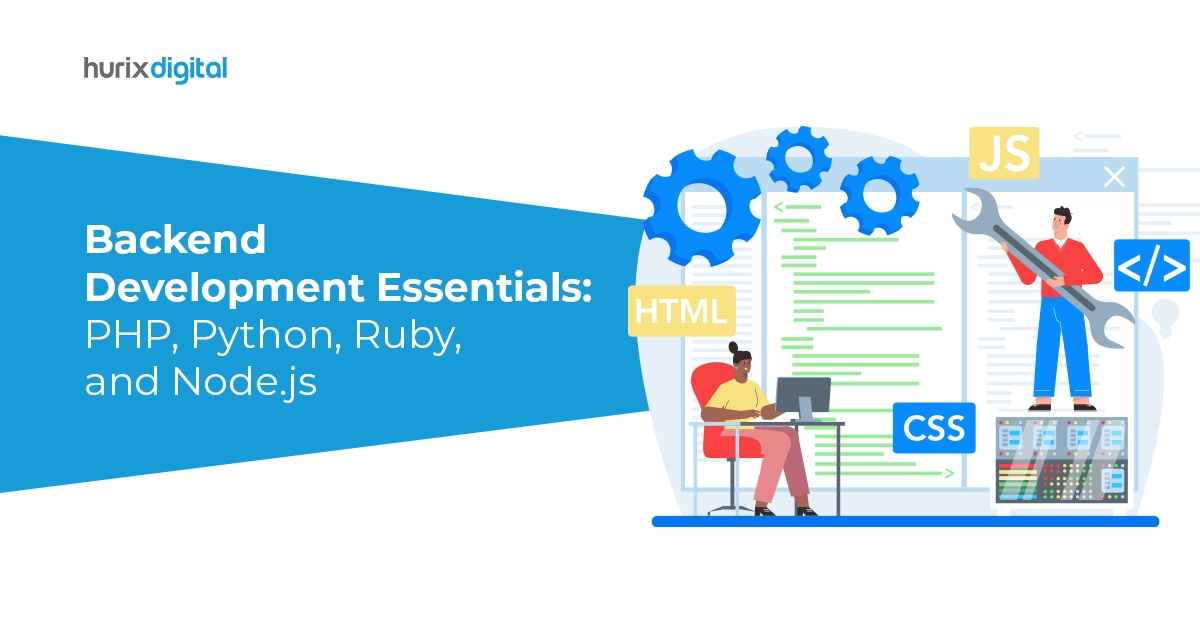
Backend Development Essentials: PHP, Python, Ruby, and Node.js
The internet, as we know it, wouldn’t function without the tireless efforts of backend developers. These digital architects craft the hidden magic behind websites and applications, ensuring smooth data flow and server-side logic.
But have you ever wondered what languages power these intricate systems?
Let’s explore the four titans of backend development: PHP, Python, Ruby, and Node.js. We’ll explore their functionalities, strengths, and ideal use cases to equip you with the knowledge to choose the perfect tool for your next project.
Table of Contents:
- What is Backend Development?
- Why is Backend Development Important?
- Server-side Programming Languages: The Powerhouse Quartet
- Beyond Languages: Essential Backend Development Skills
- Framework Comparison: Streamlining Development
- Conclusion
What is Backend Development?
Imagine a website as a restaurant. The front-end, with its attractive design and interactive elements, is the dining area where customers place orders. Backend development, on the other hand, is the bustling kitchen where chefs (programmers) prepare the food (data) and ensure smooth operations.
Backend developers handle server-side programming, interacting with databases, crafting APIs for communication, and ensuring everything runs seamlessly. Here are some key areas backend developers focus on:
- Server-Side Logic: Backend developers write code that executes on the server, processing data, handling user requests, and generating dynamic content.
- Database Integration: They establish connections between websites and databases, ensuring smooth data storage, retrieval, and manipulation.
- RESTful APIs: Building APIs (Application Programming Interfaces) allows communication between the front-end (user interface) and backend, enabling data exchange and functionality.
- Security: Backend developers implement security measures to protect user data, prevent unauthorized access, and maintain website integrity.
Why is Backend Development Important?
A well-developed backend is crucial for a website’s success. Here’s why:
- Functionality: It powers core functionalities like user authentication, data processing, and content delivery, making the website development interactive and user-friendly.
- Performance: Backend code dictates how efficiently a website responds to user requests. Backend developers optimize code for speed and responsiveness.
- Scalability: As a website grows in traffic, a robust backend can handle increased user load without compromising performance or stability.
- Security: Backend developers play a vital role in safeguarding websites from malicious attacks and data breaches.
Server-side Programming Languages: The Powerhouse Quartet
Now, let’s meet the programming languages that fuel the performance analogy – PHP, Python, Ruby, and Node.js. Each language has unique strengths and caters to different project requirements.
1. PHP: The Veteran Developer’s Companion
- A veteran in the industry, PHP (Hypertext Preprocessor) is renowned for its ease of use and extensive community support.
- Content Management Systems (CMS) like WordPress and Drupal heavily rely on PHP, making it a familiar choice for many developers.
- PHP excels in rapid development, particularly for web applications with dynamic content.
2. Python: The Versatile All-rounder
- Python’s clear and concise syntax makes it a favorite among beginners. Its extensive libraries cater to various tasks, from data science to machine learning.
- Python’s versatility shines in projects demanding robust backend logic and data analysis capabilities.
- Frameworks like Django offer a structured approach to web development, streamlining the process.
3. Ruby: The Agile Problem Solver
- Known for its ‘developer happiness’ philosophy, Ruby prioritizes code readability and a streamlined workflow.
- The popular Ruby on Rails framework provides a comprehensive structure for building web applications quickly and efficiently.
- Ruby excels in rapid prototyping and projects where development speed is a priority.
4. Node.js: JavaScript’s Backend Breakthrough
- Node.js isn’t a language itself but rather a runtime environment that allows JavaScript to run on the server side. This enables developers to use a single language (JavaScript) for both front-end and back-end development, streamlining development workflows.
- Node.js shines in real-time applications requiring constant data exchange, like chat applications or online games.
- Its asynchronous nature makes it highly scalable for handling high volumes of concurrent requests.
Beyond Languages: Essential Backend Development Skills
While languages are the tools, backend development demands a broader skillset to craft robust systems. Here are some crucial areas to focus on:
1. Database Integration: The Backbone of Data Storage
Websites and applications rely on databases to store and manage information. Backend developers must understand how to interact with databases like MySQL or PostgreSQL to efficiently retrieve, manipulate, and store data.
2. RESTful APIs: Building Communication Bridges
APIs (Application Programming Interfaces) act as intermediaries between different applications. Backend developers build RESTful APIs that adhere to specific design principles, enabling smooth communication and data exchange between various components of a system.
3. Scalability: Gearing Up for Growth
As user bases and data volumes increase, applications need to adapt. Backend developers must consider scalability measures, ensuring the system can handle growing demands without performance degradation. This might involve server optimization or implementing distributed systems.
Framework Comparison: Streamlining Development
Frameworks offer pre-written code for common functionalities, saving developers time and effort. They also promote consistent coding practices and enforce structure, leading to more maintainable codebases.
Here’s how popular frameworks for each language streamline development:
- PHP: Laravel provides built-in features like authentication, routing, and database access, reducing development time.
- Python: Django’s Model-View-Template (MVT) architecture promotes a clean separation of concerns, making code easier to understand and modify.
- Ruby: Rails’ convention over configuration approach reduces boilerplate code and allows developers to focus on application logic.
- Node.js: Express.js offers a modular design, allowing developers to choose specific features they need for their application.
Picking Your Perfect Match: A Summary Table
| Feature | PHP (Laravel) | Python (Django) | Ruby (Rails) | Node.js (Express.js) |
| Learning Curve | Moderate | Beginner-friendly | Moderate | Beginner-friendly |
| Community Size | Large | Large | Moderate | Large |
| Development Speed | Fast | Fast | Fast | Very Fast |
| Scalability | Good | Good | Moderate | Good (microservices) |
| Suitable For | CMS, E-commerce | Web Applications, Data Science | Web Applications | Real-time Applications |
Also Read: Unboxing Accessibility: Your Guide to Born-Accessible Design
Conclusion
The world of backend development is vast and exciting. PHP, Python, Ruby, and Node.js each offer distinct advantages, making the choice depend on the specific project requirements. Consider factors like project complexity, developer expertise, scalability needs, and the desired development experience.
Here at Hurix Digital, our team of experienced backend developers can help you navigate these choices and select the perfect technology stack for your project. Whether you need a dynamic website development, a data-driven application, or a real-time solution, we have the expertise to bring your vision to life.
Contact us today to discuss your project and begin a successful backend development journey.

Currently serving as the Vice President of Technology Delivery Operations at HurixDigital, a prominent global provider of digital content and technology solutions for publishers, corporations, and educational institutions. With over 16 years of experience spanning EdTech and various domains, I hold certification as a SCRUM Product Owner (CSPO). My expertise includes operations, finance, and adept people management skills.








